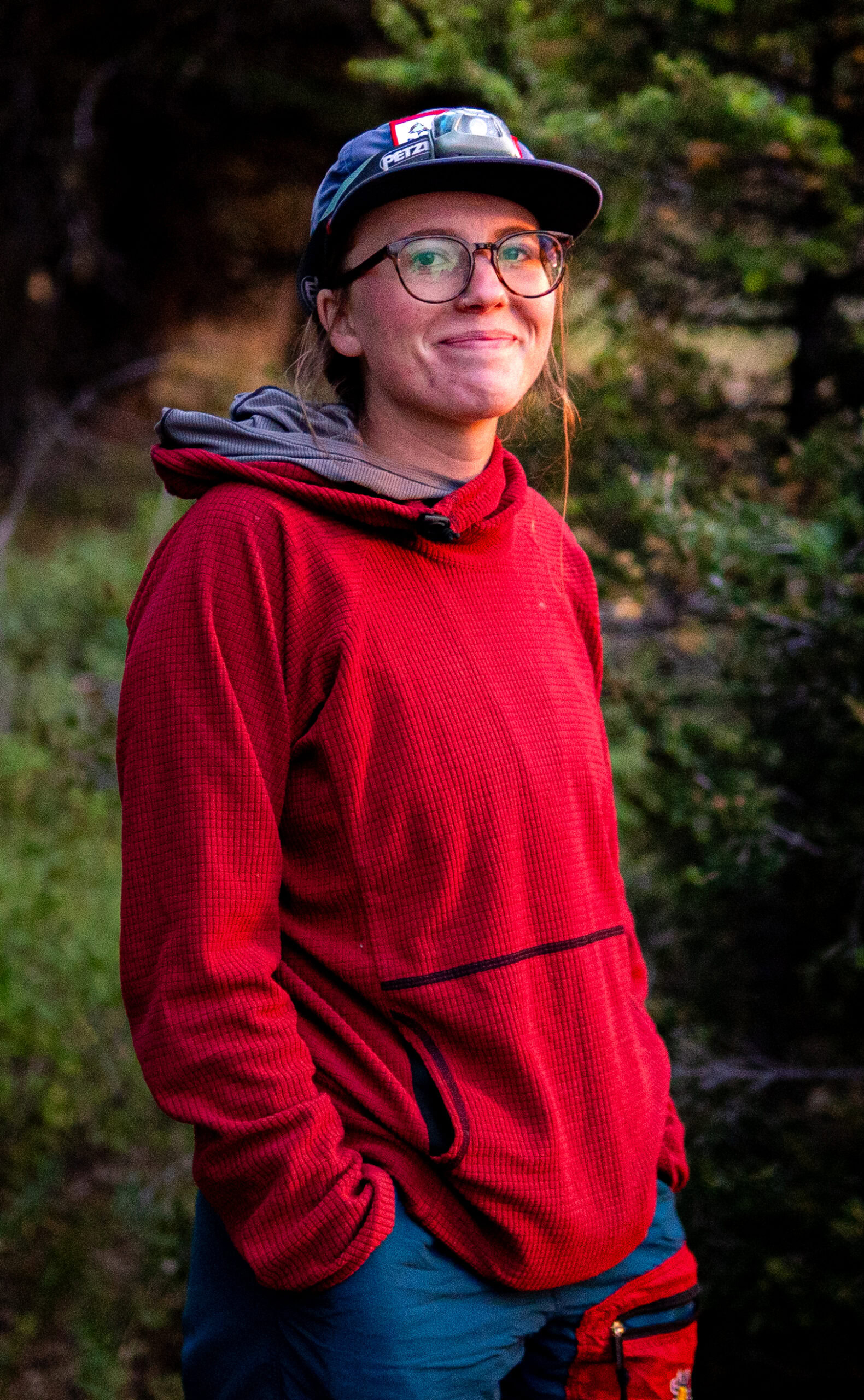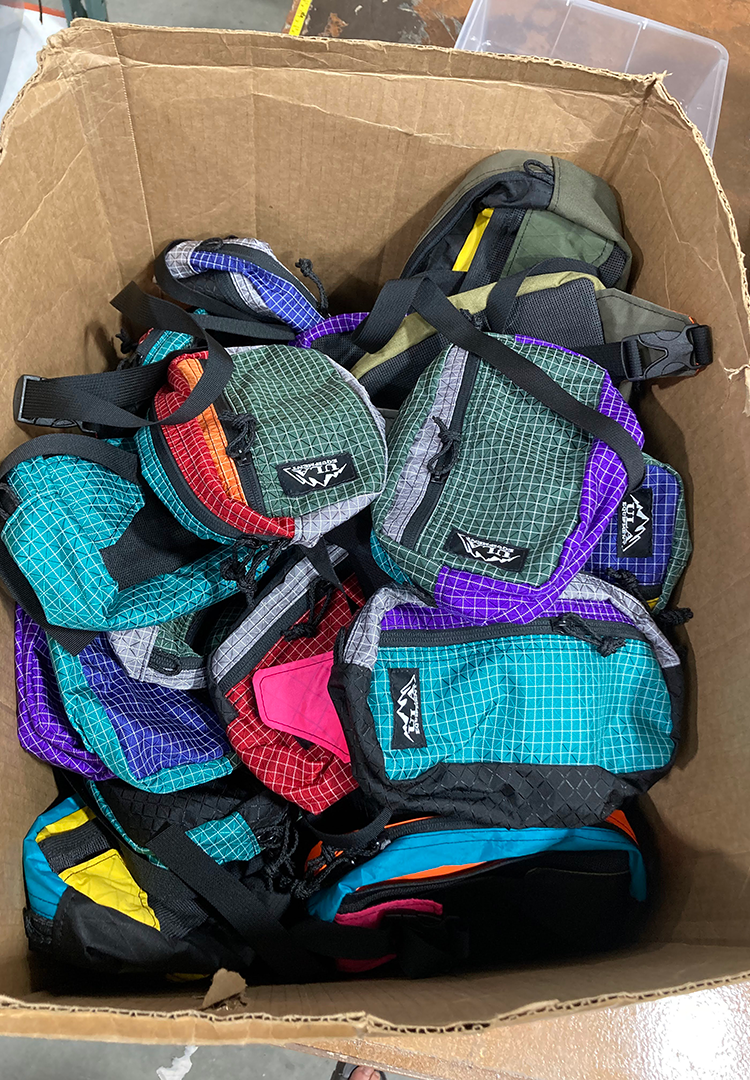
Meet the Team: Amelia Zilles
Amelia Zilles is currently on our Production, Design + Ideation team. She is a recent graduate from the Utah State University Outdoor Product Design and Development program.
Amelia’s got the grit we look for in our team members and brings an fresh perspective to the design process and our work flow.
Amelia is responsible for the recent re-design of the Spare Tire fanny pack and in addition to getting to know her a little better, we took it as an opportunity to get a little more insight into what went into this redesign process.
Profile
NAME: Amelia Zilles
ROLE: Production, Design + Ideation
BIO: I’m originally from Bowling Green, Kentucky. I moved to Logan in 2020 to pursue my degree at USU in the OPDD program. Since graduating my husband and I live full time in Logan. His family lives here and we love living in Logan.

Amelia with her family wearing Spare Tires!

Amelia’s Custom Circuit she made.

Continental Divide Trail
The Interview
ULA: Tell the people a little about yourself. What’s really going on between those ears?
AMELIA: I have a hard time making a concrete list of all my interests, haha. There are so many things I like to do in my free time; there just isn’t enough time in the day for me to accomplish all that I would like. I really like to cook, take care of my plants, play with my cat, knit and sew, and spend time with my husband, Tanner. As far as outdoor activities go, you can find me up at Beaver Mountain every Sunday in the winter and any other powder days I can “call in sick”. I learned to ski when I first moved here to Logan and I really love to spend time up on the mountain. I also like to ride my bike and I have made a few bike bags from fabric I pull from scraps at the shop. I spent the last couple of summers working on the Snake River in Jackson, Wyoming. I miss getting to live so close to Grand Teton and the river, but Logan is such a great place to live. Something that takes up a lot of my time is sewing. I really enjoy gear sewing as well as apparel sewing. I am working on a me-made wardrobe and it’s fun to create unique clothing that nobody else has.
ULA: What’s your design process like? What all goes into getting things where they’re going?
AMELIA: My design process involves a lot of back and forth. I start out with a rough pattern, and then I cut and sew it. I change the pattern based on the prototype I made and go back and forth until I find a version that I like. I think I made 20+ different versions of the new Spare Tire before I came up with a version that everybody liked. I really like the prototyping phase because I get to see the ideas in my head come to life. It’s helpful to see what does and doesn’t work and it allows me to also try out different materials. I also find it helpful to get feedback from someone who isn’t in the target user base to get their opinion on it. They can provide a perspective I wouldn’t have otherwise and can bring attention to pain points others might not have noticed. It was super helpful to have a few different people sew the design as we began production to see what parts of my pattern may have been confusing.
ULA: What was the path to working in Production and Product Design like?
AMELIA: I graduated from Utah State University in August 2023 with a BS in Outdoor Product Development and an emphasis in Operations and Supply Chain. The OPDD program does an excellent job of introducing students to design within the outdoor industry and inspired me to learn more about what I could do as a designer/developer. I have found that my industry experience has been really valuable in becoming a developer. I have worked at another, smaller cut and sew shop where I had an amazing experience learning about production of gear and the operations behind actually making gear. I didn’t know anything about product design/development before starting OPDD, so I have the program to thank for starting me on my path towards design. I really enjoyed the opportunity to learn from so many awesome professors and students in OPDD! There were so many cool classes offered that were interesting to me and really made me want to pursue a future in product design. One experience in particular was a sustainability class I took, which really opened my eyes to the industry I was working so hard to be a part of. I was exposed to the extreme amounts of waste we create as humans, and I knew that I could be part of the solution to reducing textile waste.
ULA: What types of things are you considering when designing a piece of gear? Is it just how something looks?
AMELIA: Functionality is an important factor for me. I don’t think that a bag is sustainable or beautiful if it doesn’t function well. I want to make something that someone will be excited to use and will find many functions when using it. I think that the right design will incorporate and prioritize all 3 aspects equally. I aim for the best possible outcome in everything I design and prototype.
ULA: What do you want to achieve within your role and what part of the process do you enjoy the most?
AMELIA: I really enjoy creating systems and improving efficiency, and I have gotten to do a lot of that here at ULA. I love getting to learn about cut and sew shops and smaller manufacturing processes. It’s so cool to get to see a product go from start to finish and look at ways to improve the process. With this new fanny pack the fact that there is a product that I designed out in the world and people are using it and enjoying it is such an incredible feeling. I’m looking forward to seeing how people use the fanny packs in the wild and hear whatever feedback they may have for the product. It was a lot of work to create the design, especially since I was the only designer on staff at the time, so it really put my skills to the test. I definitely got input from others here in the shop, but all the patterning came down to me. I’m proud of what I was able to create and am able to say is my project. Now, we have another designer, Owen Forbes, here in the shop and he has a lot of valuable opinions. I’m excited for what we can both create in the future!
ULA: What got you interested in Product Design?
AMELIA: I didn’t consider myself a creative person growing up, and I never expected to get a degree in design. I chose my degree as most people do–on a whim. I thought it sounded cool and it turned out I was right. I like to sew and the fact that some of my finals were sewing projects rather than exams at the testing center was a plus for me. I don’t think that design comes naturally to me like it does to other designers, but I like to create things and problem solve, so it just seemed like a good fit. So far it’s proven to be the right path and has been very rewarding.

Entropy Spare Tires

Amelia’s favorite colorways

Scenes from the production floor.
ULA: What inspires you when you’re involved in the design process?
AMELIA: I really like colorful designs and honestly can’t relate to people who buy plain black bags/clothes/items. One of my favorite things about working here is seeing all the custom backpacks that come through and seeing what color combinations people come up with. I always take pictures of the ones I like in case I ever have a hard time coming up with color combos. I also really like Pelle Cass’s work, specifically his Crowded Fields collection.
ULA: What has been the result of implementing scrap waste into our product line and what’s the future look like?
AMELIA: 12% of textiles used in apparel manufacturing end up in the landfill, mostly because they’re too small to use. With this in mind I patterned the pieces of the fanny pack to be fairly small, so that we could use some of that waste in a product. As a consumer and designer, I am very aware of waste that humans create (I could talk about it literally for hours) so it felt like an easy task to create something out of waste we make at the shop. I am currently wrapping up a new design for an ultralight trail wallet, which we’re looking to implement an Entropy(scrap pack) version of. Really any of our smaller accessories could be made out of scraps and that is very exciting. The design functions well, is lightweight, simple to make, and the pattern allows for a colorful or monotone option. In my spare time, I love to sew using garbage fabric to create useful items so this is just an extension of what I already like to do.
ULA: What did you want to accomplish with this re-design?
AMELIA: I knew I wanted something more functional and contemporary to the way that hikers actually interact with fanny packs on trail. This meant more organizational storage and a component of immediate access which is where the outer stretch mesh pocket on the back came from. I knew that we had the opportunity to use our excess fabric on this project, so I started out even making all the prototypes with scrap fabric. We have so many colors and deniers of fabric available at the shop that it was a lot of fun to make all the different iterations. We knew we wanted a more efficient hip-belt system one that was more streamlined for the user but also from a production standpoint. I don’t like the idea of drab colors and wouldn’t personally wear a gray fanny pack so with the redesign it was an opportunity to add more variations in the paneling. I wanted there to be an option for someone who wanted a more colorful option (hence the Entropy) as well as a bag with more of a “ULA look” (hence the Green Robic option). I thought it would be better to incorporate some more heritage fabrics. I liked the idea of pockets on both the inside and outside and I wanted to keep those features from the previous design. I also wanted to keep the size of the fanny pack the same. The goal with this fanny pack was that it could be worn at the same time as the Circuit/Catalyst/Ohm and serve as another hipbelt pocket, or that it could be worn alone. We wanted a smaller fanny pack, as opposed to a more robust design, like the Burst.


I loved this post! This was really inspiring, and makes me wish I had gone into design. As a woman in my almost (gasp) 50s, I wish there were more stories like Amelia’s to inspire the next generation. Thank you, ULA, for telling Amelia’s story, and thank you AmelIa, for sharing your path!
Hey Kim, thanks so much for your reply! I forwarded this to Amelia and she sent a crying face and heart emoji. This was a lot of fun to put together and I’m really happy that it resonated with you in that way. We’re very fortunate to have Amelia!
– Garrett
I proudly own a good amount of ULA gear as I appreciate the focus on “people” as well as products..!!
The two go hand in hand in the success of ULA…and in reality…any successful endeavor.
Thanks, Thom! We’re stoked to have Amelia on board and are really appreciative of the positive feedback. This was fun to put together!
– Garrett